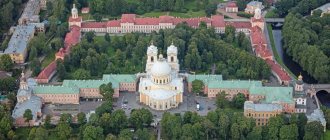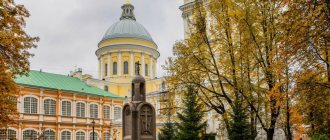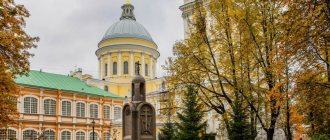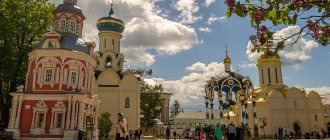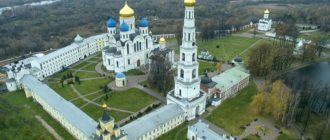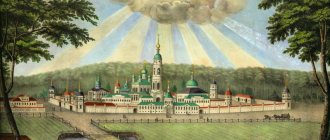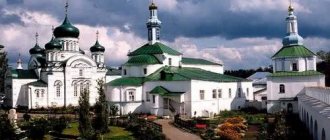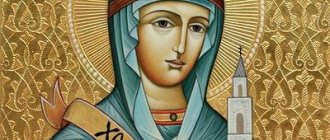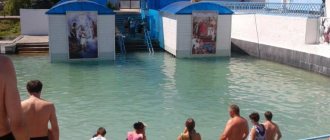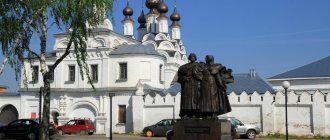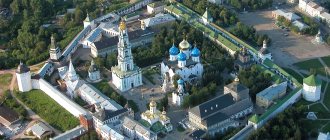The Trinity Lavra of Sergius is a visiting card, the main significant place of Sergiev Posad. It was she who gave rise to the formation of the city and became the pride of Russian Orthodoxy. From the moment of its foundation and in all subsequent times, this monastery has been and remains one of the main attractive spiritual and cultural centers. It is impossible to walk around, comprehend and evaluate all the buildings of the Lavra, and there are more than 50 of them, in one or two visits.
The monastery was always reconstructed, remodeled and updated. Life activity in it did not stop or freeze for a minute, and, probably, not a single building retained its original image. Several roads lead to the Lavra; the main gate is the Holy Gate with the Church of the Nativity of John the Baptist, built in the 17th century.
Every year, thousands of believers make a pilgrimage to the Trinity-Sergius Lavra to see the shrines of the monastery, get acquainted with its history and architecture, and take part in divine services.
Hotels near the Trinity-Sergius Lavra
Trinity-Sergius Lavra - the spiritual monastery of the Russian Church
Not far from Moscow, in the city of Sergiev Posad, there is the largest Orthodox monastery in Russia. Its church name is Holy Trinity Sergius Lavra. Created almost seven centuries ago, today it is the educational center of the Russian Orthodox Church. One of its cathedrals houses the relics of the founder of the Lavra, the spiritual ascetic of all Rus' - Sergius of Radonezh.
Sergiev Posad.
The continuation of my one-day foray from Moscow begins at the Sergiev Posad railway station, where the train took me from Aleksandrov. You can read about the beginning of my journey, what prompted me to take it, about the city of Alexandrov and Alexandrovskaya Sloboda in the article “By train to Alexandrov, Alexandrovskaya Sloboda.” Approaching Sergiev Posad, I noticed that not far from the station there was a very beautiful view of the Holy Trinity Lavra and decided to walk to this place. But first, to my amazement, at the exit from the platform I had to pass a solid cordon of police with dogs and military personnel. To be honest, I was afraid to take out my camera, everyone’s faces were too serious. There are many cafes on the station square, including McDonald's and Burger King, where you can have a snack. Having replenished my supply with the necessary calories, I went to look for the observation deck. It didn't take long to walk; it was located 400 meters from the station. I just warn you that it’s not worth repeating my hike in the rain and with children, you need to walk along a dirt path and along the railway track.
How to get to the Trinity-Sergius Lavra
You can arrive to Lavra by electric train from the Yaroslavsky station, which runs from the Komsomolskaya metro station to the suburban station Balakirevo, or to the Alexandrov station. It is also convenient to get there by bus from VDNH. Route No. 388 goes to Sergiev Posad, the interval between buses is only 10-15 minutes. All information can be found on the official website of the Trinity-Sergius Lavra.
Excursion into the history of the monastery
Founded by Sergius of Radonezh in 1337, today the Lavra reports directly to His Holiness the Patriarch. During the history of its existence, the oldest Orthodox monastery has worthily endured the consequences of the heyday and periods of oppression by state authorities. In 1920, the Lavra closed. Part of its complex was used to store museum exhibits, and part was converted into residential premises. The revival took place in 1946 and subsequent years.
The Lavra preserves the relics of not only the clergy, but also the royal Godunov dynasty. Buried on its territory are: publicist and Slavophile Ivan Sergeevich Aksakov, doctor, diplomat and thinker Konstantin Nikolaevich Leontyev, Russian philosopher and critic Vasily Vasilyevich Rozanov, and other cultural figures who served for the benefit of the development of Russian and world spirituality. The active role of the spiritual capital was inherent in the Lavra throughout the entire historical stage of its existence.
This place is associated with the names of the ascetics of Russian Orthodoxy - St. Maxim the Greek, Nikon of Radonezh, Epiphanius the Wise and other representatives of the Church. The monastery received its venerable Lavra status in 1744. From the beginning of the 16th century to the present day, a unique library of spiritual culture from handwritten and printed spiritual works is gradually being formed here.
The Lavra received its beginning as a spiritual and educational center in 1814. At this time, the Theological Academy, founded back in 1685, was located here. Today, the operating monastery continues to play a leading role in the educational, educational and spiritual spheres of the Orthodox Church.
A little history
In 1337, the future saint Reverend Sergius founded the monastery of the Life-Giving Trinity on Makovets Hill near Moscow. Gradually, the same seekers for the salvation of the soul gathered around him. The authority of the abbot continuously grew, it was he who blessed Prince Dmitry Donskoy for the battle with Temnik Mamai, the victory on the Kulikovo field became fateful for the young state. Later, during the Time of Troubles, the monastery withstood the siege of the Lithuanians, but was burned by Khan Edigei. And it was revived again, becoming the largest cultural center of the country. In 1920, the monastery was converted into a museum, but in 1946 it was returned to the church. Until 1983, the residence of the Patriarch of the Russian Orthodox Church was located here.
Bell tower of the Lavra
Bell tower of the Lavra, years of construction - from 1741 to 1768. The height of the Trinity-Sergius belfry is 88 meters, it was built according to the design of the architect D. V. Ukhtomsky. The five-tiered bell tower is considered the most beautiful in Russia. Here is the largest, weighing more than 70 tons, the Tsar Bell. The restoration of the belfry was carried out only in 2014, on the eve of the celebration of the 700th anniversary of St. Sergius.
Sergius of Radonezh.
Having looked at the Holy Trinity Lavra from the outside, it’s time to study it inside. On the way to the Lavra, in addition to a huge number of police officers, there were many pilgrims. By the will of fate, I found myself in the Holy Trinity Lavra during a big holiday. It was not difficult for me to guess what kind of holiday this was. All the streets of Sergiev Posad were full of information stands and posters, and festive inscriptions were laid out on the lawns, stating that this year is the 700th anniversary of the birth of St. Sergius of Radonezh.
The celebrations were scheduled for July 16, 17, 18, 19 and 20, 2014, and today was July 17th. In fact, the exact date of birth of the monk is not known. But it is known that either May 3, 1314, or May 1322. Therefore, most likely in 2022 we will have another anniversary, just to be sure. The date July 18 and the days surrounding it were not chosen by chance. July 18 (July 5 according to the old calendar) 1422 is the date of the discovery of the incorruptible relics of Sergius.
Assumption Cathedral
Assumption Cathedral. Construction was carried out in 1585 by decree of Ivan the Terrible. The five-domed cathedral was built in the center of the Lavra. The central golden dome was erected in honor of the Savior, the remaining domes, designed like a starry sky, are in honor of the Holy Mother of God. Externally, this is the most fundamental of the Lavra’s cathedrals. Inside, if you enter it, you create an amazing feeling of space, height and abundance of light. The temple remained unpainted for almost a century, and only in 1684, at the expense of Archbishop Moses of Ryazan, master icon painters were invited and under the leadership of Dm. Plekhanov Cathedral was decorated with frescoes depicting saints and noble persons of the princely family. The main shrine of the Cathedral remains the funeral of Sergius of Radonezh.
Church of the Solovetsky Wonderworkers
Church of the Solovetsky Wonderworkers. Construction time: 1635-1637. This is the only tented temple in the Lavra, which houses a shrine - the ancient icon “The Sign”, with the image of Zosima and Savvaty of Solovetsky, appearing before the appearance of the Mother of God. The temple is part of a complex of buildings created in different historical periods, the buildings of which house the monastery library, the chambers of the governor of the Lavra and the Cathedral Chamber.
Church of St. John the Baptist
The Church of St. John the Baptist (1693-1699) was created on the site of the main gate to the Monastery and was erected at the end of the 17th century at the expense of the philanthropist G. Stroganov. At the time of its construction, the haram looked somewhat different; the five-domed structure was restored at the end of the last century, already under the leadership of V.I. Baldin, this architectural solution emphasized the stylistic commonality of the entire ensemble of the Trinity-Sergius Lavra. The magnificent iconostasis in the Church of St. John the Baptist is well lit and surprises with its splendor.
History of Sergiev Posad.
The history of Sergiev Posad, as well as its attractions, are closely connected with the Lavra. In the middle of the 14th century, Sergius of Radonezh and his friend cut down the first cell and wooden church in the name of the Trinity on the site of the future Lavra, after which believers and followers of Sergius flocked here. The monastery itself was slowly overgrown with buildings, and the glory of the miracles of St. Sergius reached Moscow. According to legend, Dmitry Donskoy himself came to the monastery in 1380 to receive a blessing for the Battle of Kulikovo. To get to the Lavra, I walked along the newly paved huge Red Army Avenue - the main transport street running through the entire city right in the middle. The avenue was closed to both cars and people on the occasion of the holiday.
The golden dome of the five-tiered bell tower of the mid-18th century Lavra could be seen from almost anywhere in Sergiev Posad. The height of the bell tower is 88 meters. This is the tallest building of the Holy Trinity Lavra, equipped with the largest bell in Russia (72 tons).
The photo of the bell tower below was taken from the territory of the Holy Trinity Lavra.
Nowadays, next to the walls of the Lavra there are two sub-district churches: Vvedenskaya and Pyatnitskaya.
There is also a monument to the parents of St. Sergius of Radonezh, Cyril and Mary of Radonezh, from grateful descendants.
The area around the Lavra is generally well-groomed, but it seems that it was done recently: there is little greenery and flowers, in some places there is just plowed land.
To understand where and what is, you need a plan.
Refectory Church
Church of St. Sergius with the Refectory Chamber (1686–1692).
These are not all the temples and cathedrals of the Trinity-Sergius Lavra. Each of the buildings has its own history, characteristics and spiritual and cultural value. And all together they form an amazing place, the center of history, spirituality, artistic rarities and the center of spiritual Orthodox culture in Rus'.
In addition to churches and temples, on the territory of the Lavra there is a source of spring water, where anyone can quench their thirst.
It seems important to say a few words about the founder of this center, hieromonk of the Russian Church Sergius of Radonezh (1314-1392). His name personifies the beginning of Russian spirituality. Despite the fact that he did not leave written evidence, he preserved his memory in his spiritual mentoring, as well as in his practical work pleasing to God - the creation of monasteries. In the spiritual sphere, he is considered the patron saint of students. In the 15th century he was ranked among the Order of Saints by the Orthodox Church. In 1969, by order of Pope Paul VI, his name was included in the calendar of services of the Roman Catholic clergy.
Relics of St. Sergius of Radonezh.
Without belittling the importance of any of the saints whose relics rest in the Trinity-Sergius Lavra, but solely for the purpose of revealing the theme of the lavra, let us note some facts from the history of the relics of St. Sergius of Radonezh.
The Monk Sergius of Radonezh died on September 25 (October 8, New Art.) 1392. The saint humbly bequeathed to lay his body not in the church , but in the general monastery cemetery along with others. However, the authority of Sergius and the love of the brethren for him forced them to seek advice from Metropolitan Cyprian , who ordered Sergius to be buried in the Trinity Church. This was the beginning of the posthumous veneration of St. Sergius of Radonezh.
on the page menu
Finding the relics of St. Sergius of Radonezh.
On July 5 (18 New Art.), 1422 , 30 years after the death of Sergius, in connection with the construction of a new stone church on the site of the old wooden Trinity Church, the saint’s remains were recovered and appeared incorrupt. This day is celebrated as the day of the discovery of the relics of St. Sergius of Radonezh . The wooden coffin in which the body of the saint was in the ground for the first 30 years is kept as a shrine in the Assumption Cathedral of the Trinity-Sergius Lavra. Now it is covered with a glass sarcophagus, because when kissing it, many believers tried to bite off a piece of the shrine.
on the page menu
Canonization of Sergius of Radonezh.
official procedure for the canonization of saints in the Orthodox Church until 1547, when the first Makariev Council took place. But the veneration of Sergius of Radonezh had already arisen, and in 1439 attempts began to somehow consolidate his status as a saint. However, it was not possible to do this for almost 10 years, both for political reasons - the capture of Grand Duke Vasily the Dark, and for internal church reasons - the absence of an official metropolitan in Rus'. However, already in 1448, princely charters appeared in which Sergius of Radonezh was mentioned as a locally revered saint. The exact date of the statewide canonization of Sergius is also not known. It is assumed that this happened in the period from 1449 to 1452 , and the document testifying to this is considered to be a letter from Metropolitan Jonah to Dmitry Shemyaka.
In connection with the canonization of Sergius of Radonezh, it is necessary to mention the opinion of St. Maximus the Greek , who openly expressed doubts about the holiness of Sergius . The reason for the doubts was that Sergius, like the Moscow saints, “kept cities, volosts, villages, collected duties and quitrents, and had wealth.”
In 1585, the relics of St. Sergius of Radonezh were transferred from a wooden shrine to a gilded silver shrine, made by order of Ivan IV the Terrible. The king himself was already dying by this time (March 18 (28 New Art.), 1584).
In 1737, by order of Empress Anna Ioannovna, a silver canopy was placed over the shrine containing the relics of the saint.
During the entire pre-revolutionary period, the relics of St. Sergius of Radonezh left the Lavra 3 times:
- 1709 - during a fire, the relics were taken to Krasnogorskaya Square in front of the Lavra.
- 1746 - during a fire, the relics were taken to the outskirts of the city.
- 1812 - during the war with Napoleon, the relics were taken to the Kirillo-Belozersky Monastery.
on the page menu
Opening of the relics of Sergius of Radonezh.
On January 20 (February 2, New Art.), 1918, the Council of People's Commissars of the RSFSR adopted a Decree on the separation of church from state and school from church. The decree came into force three days later on January 23 (February 5, new style) 1918 and was canceled by a resolution of the Supreme Council of the RSFSR dated October 25, 1990. Especially for the implementation of this decree, the V Department (later became the VIII Department) was organized at the People's Commissariat of Justice (NKYU), headed by Comrade P.A. Krasikov. An interesting fact is that one of the members of the commission for preparing the decree and even its possible initiator was priest (!) Mikhail Galkin , rector of the Church of the Transfiguration of the Lord in Petrograd.
With this decree, the Bolsheviks launched a nationwide anti-religious campaign, which resulted in the looting and closure of most religious institutions of all faiths, and its apotheosis was physical destruction, imprisonment, and expulsion of the clergy. An important element of this campaign was the opening and removal of the relics of saints from churches.
The opening of the relics of St. Sergius of Radonezh took place on Friday, April 11, 1919, on the eve of Lazarus Saturday.
Before this, on April 1, 1919 , a General Meeting of the Council of Workers' and Peasants' Deputies of Sergiev Posad was held, at which the Communist faction made a proposal to open the relics of Sergius, “considering that the relics of Sergius are a means of vulgar exploitation of the uninformed masses and a basis for malicious agitation of the black clergy” (quote from minutes of the meeting). On April 4, 1919, the Moscow Provincial Executive Committee approved the decision of the Sergievsky Council of Deputies of April 1, 1919 on the opening of the relics of St. Sergius.
However, even before this meeting it was clear that the relics of St. Sergius would be opened, since the Soviet press widely covered dozens of autopsies that had already been performed and it was clear that this was elevated to the rank of state policy.
Anticipating the impending events during the Week of the Cross, the professor of the Moscow Theological Academy (located in the Trinity-Sergius Lavra) and the rector of the academic Church of the Intercession, Hieromonk Bartholomew , preached a sermon about the possible threat of opening the relics of Sergius and called on worshipers to sign an appeal for the preservation of the relics. The next day, the same hieromonk Bartholomew delivered an even more fiery sermon, in which he said that the Antichrist had appeared in Russia and that “Christ is now being crucified in Russia for the second time . The monks of the Lavra began to collect signatures from citizens for the preservation of the relics. In total, about 5,000 signatures were collected, which probably constituted almost the entire literate population of Sergiev Posad, since in total about 20,000 people lived in the city at that time. (On July 10, 1935, Bartholomew was shot in Butyrka prison.)
But the machine of communist anti-religious terror could no longer be stopped. On April 11, representatives of the volosts and clergy, invited to the opening of the relics, began to gather in the executive committee of Sergiev Posad (Sergiev Posad was then renamed Sergiev). The invitees were not informed about what exactly would happen, but some guessed.
To avoid possible unrest, a company of cadets stationed in the Lavra occupied all the bell towers of the Lavra, the gates and posted posts on the walls. The keys to the monastery premises were confiscated from the monks.
People began to gather on Krasnogorskaya Square in front of the entrance to the Lavra. Mounted police lined up behind them.
After 5 p.m., government officials and guests enter the Lavra and go to the assembly hall of the Theological Academy. The governor of the Lavra, Archimandrite Kronid, also comes here.
Chairman of the Executive Committee O.G. Vanhanen informs Kronid that the relics will be opened and it is desirable that this be done by the representatives of the clergy themselves. Kronid refuses to personally open the relics and reports that the relics will be opened by the dean of the laurels, Hieromonk Jonah.
Everyone goes to Trinity Cathedral. A lot of people gathered. Believers delegated from the crowd in front of the Lavra were also allowed here. Equipment for film and photo shooting is installed.
At 20:50 the opening of the relics of Sergius of Radonezh begins. At 22:50 the autopsy is completed.
The entire procedure is filmed on camera under the direction of director Lev Kuleshov. Unfortunately, the quality of filming turned out to be poor and not all moments of the autopsy are visible. Among believers, this fact was interpreted as one of the saint’s miracles.
Stills from this film are available on the Internet: Autopsy of the relics of St. Sergius of Radonezh.
After the opening, the relics of St. Sergius of Radonezh were left in their original place and, together with the Trinity Cathedral, moved to the newly formed historical and art museum.
on the page menu
Chapter of Sergius of Radonezh.
The history of the opening of the relics of St. Sergius of Radonezh contains another interesting and important point: Priest Father Pavel Alexandrovich Florensky , a professor at the Moscow Theological Academy, learned from the mother-in-law of one of the commissars of Sergius Posad about the impending autopsy of the relics of St. Sergius of Radonezh. The events that followed are unknown for certain and have been preserved only in the form of family legends of the descendants of P. Florensky. According to one version, it is assumed that Florensky, being concerned about the safety of the relics of St. Sergius, reported the information received to the viceroy of the Lavra, Archimandrite Kronid (K.P. Lyubimov) and Count Yu. A. Olsufiev , a member of the Commission for the Protection of Monuments of History and Antiquities of the Trinity-Sergius Lavra . Then they secretly entered the Trinity Cathedral and separated the head (skull) of the saint, which they replaced with the head (skull) of Prince Trubetskoy, buried in the cathedral . The head of Sergius of Radonezh was hidden in the sacristy, from where Count Olsufiev then moved it into an oak ark and brought it to his home.
It is not known exactly when the chapter was separated, before the opening of the relics or after, since there are no documents and there should not have been. Oral evidence from the descendants of Pavel Florensky is somewhat contradictory. Presumably, the separation of the head of the saint from the main body of relics could have occurred in the period from several days before the opening of the relics until the end of March 1920, when the authorities planned to transport the relics from the Trinity-Sergius Lavra to one of the Moscow museums. However, the fact of the separation of the chapter itself is not disputed.
Olsufiev kept the ark with the head of the saint in his house, and in 1928 he buried it in the garden and left for Moscow. Unfortunately, the further history of the preservation of the holy relic becomes even more ambiguous and for this reason I will limit myself to only stating that in 1946 the relics of St. Sergius of Radonezh were reunited with the head.
All participants in the secret branch of the head of St. Sergius of Radonezh were subsequently arrested and shot:
- Archimandrite Kronid (Konstantin Petrovich Lyubimov) - executed on December 10, 1937 at the training ground in Butovo. In 2000 he was canonized.
- Pavel Aleksandrovich Florensky - executed on December 8, 1937 near Leningrad
- Yuri Aleksandrovich Olsufiev - executed on March 14, 1938 at the training ground in Butovo
A documentary film, The Fifth Mark, was made about the history of the preservation of the head of Sergius of Radonezh. The mystery of Sergiev Posad.
on the page menu
Evacuation and return of the relics of Sergius of Radonezh.
In the fall of 1941, the relics, along with other valuables of the Trinity-Sergius Lavra, were evacuated to the city of Solikamsk. In 1946, before Easter, part of the Trinity-Sergius Lavra was returned to the Moscow Patriarchate, including the relics of St. Sergius with a shrine and canopy. But the Trinity Cathedral still remained part of the Sergiev Posad State Historical and Art Museum-Reserve and the relics were temporarily located in the Dormition Cathedral Lavra. Currently, the relics of St. Sergius of Radonezh rest in their historical place in the Trinity Cathedral.
It will be useful for visitors to the Trinity-Sergius Lavra to know
- Wedding, baptism and funeral ceremonies in monasteries are prohibited in accordance with Orthodox canons; services for the health and repose of loved ones can be ordered.
- Photography on the territory of the monastery has a number of restrictions: you cannot use flash indoors, you cannot take pictures of the monks.
- It is necessary to comply with the norms for visiting existing monasteries; for women - a headdress, closed clothing (as for men), drinking alcohol and smoking is unacceptable on the territory of the monastery.
- For visitors, the Trinity-Sergius Lavra is open from 5 am to 9 pm. You can visit the monastery around the clock on church holidays, on the Days of Remembrance of St. Sergius.
- Excursion services are provided in the summer from 9 a.m. to 6 p.m.; from November 11 to April 30, the excursion service time is reduced by an hour to 5 p.m.
The Holy Trinity-Sergius Lavra is interesting, first of all, as a spiritual and cultural Russian center. This is more than a magnificent example of Russian architecture, icon painting, forms and methods of implementing Russian Orthodoxy. It is a living source of wisdom, strength and energy, an experience of faith reflected in creativity and cultural heritage. The Lavra preserves the traditions of the faith, prepares spiritual followers for itself in the Orthodox gymnasium, parochial schools at the Voznesensky and Pyatnitsky metochions, and in the military-historical club “Peresvet”.
The spiritual guidance of Sergius of Radonezh: “... I pray to everyone... have the fear of God and purity of soul and body and unfeigned love...” and this is the key to the great wisdom of life, which is far from being limited by the walls of the Lavra, can be a parting word into the world for every civilized modern person.
Reviews and comments from tourists, pilgrims and ordinary visitors
Anastasia: “On the territory of the monastery there is the impressively beautiful Trinity Cathedral, and this is its main attraction. It’s hard to call me a believer, but even I was amazed. It is also a historical relic; it was interesting to take a closer look at it. The high ancient walls and domes were impressive. It is not for nothing that the Lavra today, yesterday and even tomorrow played and is playing a major role in the spiritual enlightenment of people.”
Dmitry: “I visited the Lavra for the first time. Today my childhood dream came true. I never regretted it, even though I traveled quite far. The only thing I was worried about was the place to stay, but it turns out that the monastery also includes two hotels where you can stay comfortably.”
Sergey: “The Lavra is impressive in its scale. When I imagine that all this was still being built when Mamai went to Rus', it fills me with indescribable delight. The priests are friendly, I accepted confession.”
The Trinity Lavra of St. Sergius is the center of Russian Orthodoxy. It was founded by Sergius of Radonezh at the beginning of the 14th century. Since then, the monastery has been rebuilt and restored, but has managed to preserve both its spiritual and historical significance. Every year hundreds of thousands of pilgrims from all over the world come to the Lavra. Many people strive to join the holy relics of Sergius of Radonezh.

